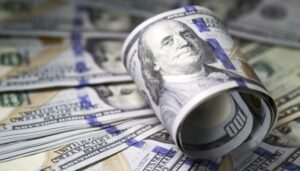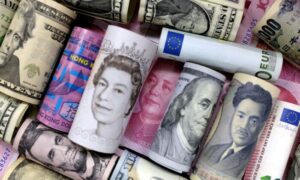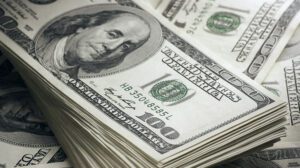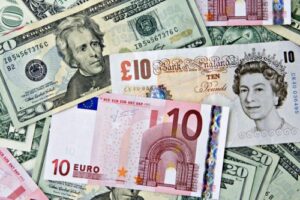
The Japanese yen is depreciating against the US dollar on Monday morning.
The US dollar exchange rate against the yen at 8:56 am CST was 144.8 yen compared to 144.72 yen on Friday. During the session, the yen fell below 145 yen per $1, which could provoke the Japanese government to conduct foreign exchange intervention for the second time this year, writes Bloomberg.
The Japanese currency fell to 145.9 yen per dollar on September 22, after which the country’s Ministry of Finance decided to intervene in the foreign exchange market for the first time in 24 years. In total, authorities spent 2.84 trillion yen ($19.65 billion) in September to support the national currency, the ministry said.
The weakening of the yen comes against the backdrop of the Bank of Japan maintaining a loose monetary policy, while other central banks of the world have begun to tighten it due to inflation, beating multi-year records. In total, the yen has lost 21% since the beginning of the year.
“The yen is at risk of further depreciation as long as the BOJ’s yield curve control remains status quo and other central banks, including the Fed, continue to tighten or normalize policy,” said Oversea-Chinese Banking Corp. strategist. Christopher Wong.
Meanwhile, the ICE index, which shows the dynamics of the US dollar against six currencies (the euro, the Swiss franc, the yen, the Canadian dollar, the pound sterling and the Swedish krona), is down 0.27%, the broader WSJ Dollar is down 0.29%.
The euro/dollar pair is trading at $0.9822 compared to $0.9802 at the close of the session on Friday, the euro adds 0.2%.
The pound rose 0.7% to $1.1246 compared to $1.1168 at the close of the previous session.

The pound sterling again falls against the dollar due to renewed concerns about the British budget deficit amid announced tax cuts.
The pound by 9:05 a.m. fell 1% to $1.0782 compared to $1.0891 at the close of the previous session.
On the eve of the British currency rose after statements by the Bank of England about its intention to start buying long-term government bonds in an unlimited amount to stabilize the market, but the rise was short-lived.
Earlier this week, the pound hit a new all-time low against the dollar, and its fall since the beginning of the month could be a record since June 2016, when the British voted to leave the European Union.
The ICE-calculated index, which shows the dynamics of the US dollar against six currencies (the euro, Swiss franc, yen, Canadian dollar, pound sterling and the Swedish krona), rose by 0.85%, the broader WSJ Dollar – by 0.6%.
The euro/dollar pair is trading at $0.9668 compared to $0.9736 at the close of the session on Wednesday, the euro is losing about 0.7%.
The rate of the American currency against the yen increases by 0.4% and amounts to 144.64 yen compared to 144.12 yen the day before.
Meanwhile, the Chinese yuan is rising against the dollar for the first time in nine sessions. The yuan traded in mainland China rose to 7.1963/$1 from 7.2005/$1 at the close of the previous session.
The People’s Bank of China (PBOC, the country’s central bank) released a statement last night warning speculators that they would definitely lose money in the long run on betting on a weakening yuan and called on key market players to “protect the authority of the reference rate.”
The yuan on the mainland has fallen about 4% since the start of the month, and on Wednesday it hit a new low since 2008. Meanwhile, the offshore yuan traded in Hong Kong has fallen to its lowest level since the introduction of a separate trading system in 2010.

The Chinese yuan fell against the dollar to its lowest level since 2008 amid signals from Beijing weakening support for the currency.
The yuan, which trades on the territory of mainland China, fell to 7.2235/$1 compared to 7.176/$1 at the close of the previous session. The value is at the lowest level in 14 years.
The People’s Bank of China (PBOC, the country’s central bank) signaled it was prepared to allow the yuan to weaken, setting a reference rate of 7.1107 yuan/$1, the lowest level in more than two years. The market rate of the yuan may deviate from the reference rate by no more than 2% in one direction or another during the session.
The offshore yuan (traded in Hong Kong) fell to a record low since the introduction of the separate trading system in 2010 and stands at 7.2298 yuan/$1 by 09:00 Moscow time against 7.1795 yuan/$1.
Meanwhile, the US dollar is actively growing against other currencies on Wednesday morning. The ICE-calculated index, which shows the dynamics of the dollar against six currencies (the euro, the Swiss franc, the yen, the Canadian dollar, the pound sterling and the Swedish krona), adds 0.38% in the course of trading. The broader WSJ Dollar is up 0.3%.
The EUR/USD pair is trading at $0.9564 as of 9:10 Moscow time, compared to $0.9596 at the close of the previous session.
The pound sterling depreciates in the course of trading to $1.0696 compared to $1.0734 the day before.
And only the yen slightly rises against the dollar and is 144.67 yen at 09:11 Moscow time against 144.81 yen following the results of the previous session.
Experts believe that the US currency will continue to strengthen against the background of the rapid tightening of monetary policy by the Federal Reserve System (FRS). In addition, the dollar is supported by a decrease in risk appetite in world markets.
A further increase in volatility in financial markets will help strengthen the dollar due to its status as a “safe haven” currency, said Carol Kong, an analyst for the CBA foreign exchange market.

The dollar continues to decline against the euro, yen and pound sterling on Tuesday after a steady rise in previous trading.
The ICE-calculated index, which shows the dynamics of the dollar against six currencies (the euro, the Swiss franc, the yen, the Canadian dollar, the pound sterling and the Swedish krona), is losing 0.5% in the course of trading. On the eve of the indicator has updated a 20-year high.
The recent rise in the dollar has created an “unacceptable situation” for risky assets that tends to lead to financial or economic crises, said Morgan Stanley strategist Michael Wilson, quoted by MarketWatch.
The euro/dollar pair is trading at $0.9642 as of 3:00 pm compared to $0.9609 at the close of the previous session. On the eve of the euro has fallen in price against the dollar by 0.8%.
The pound sterling rose during trading to $1.0796 compared to $1.0688 the day before. The dollar against the yen fell to 144.47 yen against 144.74 yen in the previous session. On Monday, the US currency gained 1.5% against the pound and 1% against the yen.
The dollar is correcting as investors seek to take profits after its significant strengthening, according to Trading Economics. Experts believe that the US currency will continue to strengthen against the background of the rapid tightening of monetary policy by the Federal Reserve System (FRS). In addition, the dollar is supported by a decrease in risk appetite in world markets.
A further increase in volatility in financial markets will help strengthen the dollar due to its status as a “safe haven” currency, said Carol Kong, an analyst for the CBA foreign exchange market.

The pound sterling fell sharply against the US dollar during morning trading on Monday and hit a historic low on signals from the British Treasury about the likelihood of new tax breaks in addition to those announced last week.
The pound by 8:50 Moscow time fell by 2.6% and is $1.0570 compared to $1.0850 at the close of the previous session. Earlier in the day, the rate fell to $1.0327, which is the lowest level since 1971, when the UK switched to a decimal currency system.
Last week, UK Treasury Secretary Quasi Kwarteng announced a massive tax cut that will affect individuals and businesses and increase the budget deficit for the current fiscal year by more than 70 billion pounds.
“This government has only been in office for 19 days,” Kwarteng told the BBC on Sunday. “In the coming year, I would like to see people keep even more of their income because I believe the people of the UK will be the engine of the country’s economy.”
The market regarded this as a hint of new tax incentives, writes Bloomberg.
The ICE-calculated index, which shows the performance of the US dollar against six currencies (the euro, the Swiss franc, the yen, the Canadian dollar, the pound sterling and the Swedish krona), rose by 0.75%, exceeding 114 points for the first time since May 2020, according to Trading Economics .
The dollar is supported by the demand for defensive assets caused by fears of a global recession. In addition, currency traders point out that the Fed is tightening monetary policy at a faster pace than the rest of the world’s leading central banks.Pair pound / dollar has updated a historical low
The euro/dollar pair is trading at $0.9636 compared to $0.9690 at the close of the session last Friday, the euro loses about 0.6% and again updates the lows in two decades.
The rate of the American currency against the yen increases by 0.4% and amounts to 143.87 yen compared to 143.34 yen last Friday.

The euro and the pound sterling fell to multi-year lows against the US dollar in trading on Friday.
The ICE-calculated index showing the dynamics of the dollar against six currencies (the euro, the Swiss franc, the yen, the Canadian dollar, the pound sterling and the Swedish krona) soared to a record level, exceeding 112 points.
As of 15:10 Moscow time, it adds 0.78%, the broader WSJ Dollar Index – 0.74%.
The euro/dollar pair is trading at $0.9754 compared to $0.9838 at the close of the previous session. During the session, the euro exchange rate updated the minimum since 2002, dropping to $0.9737.
The pound sterling, meanwhile, hit a new low since 1985 against the dollar, dropping to $1.1020. By 15:10 Moscow time, the pound exchange rate is $1.1062.
The US currency is supported both by expectations of further tightening of the Federal Reserve System (Fed) policy, and by a general increase in demand for “safe haven” assets in the face of growing geopolitical tensions and forecasts of a global recession.
The euro remains under serious pressure due to growing fears of a protracted war on the territory of Ukraine after the announcement of partial mobilization in Russia, Market Watch notes.
The Eurozone Composite Purchasing Managers’ Index (PMI) fell to 48.2 in September from 48.9 in August, according to preliminary data from S&P Global. The index value indicates a decline in activity in the region for the third month in a row.
The Fed’s hawkish statements have prepared investors for a long cycle of rate hikes in the US, said Thomas Flury, an economist at UBS Global Wealth Management. “Given forecasts of a recession in Europe as a result of the intensifying energy crisis, the euro against the dollar will continue to decline.”
Meanwhile, Britain’s Chancellor of the Exchequer, Kwazi Kwarteng, presented the government’s new plan to the House of Commons on Friday, which would see massive tax cuts to support the ailing economy. The British Debt Management Office (DBO) raised its estimate of the state budget’s borrowing needs for the current fiscal year by almost 1.5 times after the tax cut announced on Friday.
The dollar rose to 142.73 yen against the yen from 142.37 yen at market close on Thursday.
The US dollar against the yuan rose 0.6% to 7.1193 yuan. During the session, it rose to the level of 7.1173 yuan, which is 1.8% higher than the reference rate set by the Chinese Central Bank on Friday. The People’s Bank of China allows exchange rate fluctuations of 2% from the reference in one direction or another. A deviation of more than 1.9% was last recorded in August 2015.